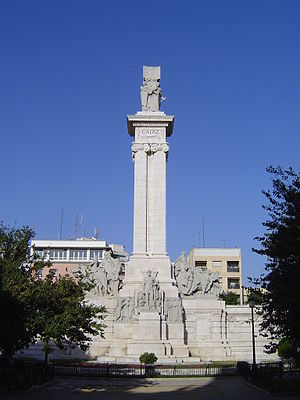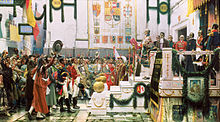Cortes of Cádiz

The Cortes of Cádiz was a revival of the traditional cortes (Spanish parliament), which as an institution had not functioned for many years, but it met as a single body, rather than divided into estates as with previous ones.[1]
The General and Extraordinary Cortes that met in the port of
The Cortes of Cádiz was seen then, and by historians today, as a major step towards liberalism and democracy in the history of Spain and Spanish America. The liberal Cortes drafted and ratified the Spanish Constitution of 1812, which established a constitutional monarchy and eliminated many institutions that privileged some groups over others.[5]


Background
Napoleon's armies invaded Portugal (1807) and then Spain (1808), upending the Bourbon monarchy. At the time of the invasion, Charles IV had been at serious odds with his son and heir Ferdinand VII. In March 1808, the
After the
From the first days of the
Convoking the Cortes

The Supreme Central Junta dissolved itself on 29 January 1810 and set up a five-person Regency, charged with convening the Cortes. The Regency drew up a list of American-born Spaniards already present in Spain. By the time the delegates were to be chosen, some of Spain's American territories had successfully established their own juntas. These did not recognize the authority of either the central junta or the regency and so did not send representatives although many other regions in America did. The Regency made the decision to have the Americans elect representatives from their regions to attend the Cortes. Since part of Spanish America was in open revolt, this question of representatives from those regions was fraught. It was argued that the process was illegal, but the Regency decided it was better to have some American representation than none at all. The Regency set electoral procedures for delegates and the number of seats from each region. There were to be 30 representatives from Spanish America: 15 from northern Spanish America plus the Philippines (which was under the administrative jurisdiction of New Spain). New Spain was allocated 7 suplentes: Guatemala, 2; Cuba, 2; the Philippines, 2; Santo Domingo and Puerto Rico, 1; Spanish South America got 15: Peru, 5; Santa Fé, 3; Buenos Aires, 3; Venezuela, 2; and Chile, 2. Those eligible to serve were to be at least 25 years old and from the place they would represent.[8] Not made explicit was that only males were eligible to serve.
When the Cortes convened for the first time on 24 September 1810, 104 deputies were present, 30 representing overseas territories (interim delegates who were living in Spain at the time of the French invasion). Only one of the 36 American deputies arrived in time for the opening session, Ramón Power y Giralt. Eventually, about 300 deputies, including 63 from the Spanish America, participated. The composition of the Cortes of Cádiz was diverse, with about one-third clerical, one-sixth nobles and the remainder from the "third estate", the middle class.[4] Historians of Mexico have investigated many aspects of New Spain's representation at the Cortes.[9] Among the most prominent delegates at the Cortes were José María Couto, who served as vice president in April 1813; José María Gutiérrez de Terán, who served as secretary, vice president, and president at various points; and Miguel Ramos Arizpe.[10]

Influences on the Cortes
The fact that the Cortes was located in Cádiz, the most important port for trade with the Americas, meant that the powerful merchant guild (
Gaspar Melchor de Jovellanos, who had served as Charles IV's minister of justice but had been sidelined by Manuel Godoy, argued for the convocation of a general Cortes. Jovellanos sought precedents in Spanish history for earlier forms of constitutionalism and found them in the Visigoths. Jovellanos rejected the notion that the Cortes could fundamentally change "the essence of our ancient constitution," and was concerned that sweeping changes would open Spain to the dangers of democracy and despotism. However, he did argue for the independence of the executive, the judiciary, and the legislature, but also argued for a bicameral legislature that would have an upper house reserved for the aristocracy. He advocated voting rights based on "qualities of property, rank, and education," to limit democracy.[15]
Seville-born
Reforms and constitution

In its first session, the Cortes promulgated the proposition that it, rather than the king, was the national sovereign since it represented the people. Then, the national assembly divided the government into legislative, executive and judiciary branches. Given the contingencies of war that resulted from the forced displacement of
The national assembly restructured the government while prosecuting a war in Spain and maintaining control overseas. Once deliberations started, the delegates split into liberal and conservative factions. Conservative Spaniards saw the Cortes at Cádiz as, at best, an interim solution until "the Desired One", as Fernando VII was called by his supporters, could be restored to the throne. Most
The product of the Cortes' deliberations reflected the liberals' dominance. The
Its first regulation includes one of the first examples of a seasonally adjusted schedule, a practice which led to the adoption of
Aftermath
A revolutionary document, the Spanish Constitution of 1812 marked the initiation of the Spanish tradition of liberalism, and when Fernando VII was restored to the throne in 1814, he refused to recognize it. He dismissed the Cortes Generales on 4 May and ruled as an absolute monarch. These events foreshadowed the long conflict between liberals and traditionalists that marked Spanish history in the 19th and early 20th centuries.
The Cádiz Cortes declared that the
Spain's American colonies took advantage of the postwar chaos to proclaim their independence. Most established republican governments. The fact that the Constitution was considered too liberal by the conservative elements in the colonies only precipitated their decision to join the effort for independence from Spain. When Ferdinand was restored to the throne in Madrid, he expended wealth and manpower in a vain effort to reassert control over the colonies. The move was unpopular among liberal officers assigned to the American wars. By the second half of 1826 only Cuba and Puerto Rico remained under the Spanish flag in the Americas, with the Philippines and Guam also under Spanish rule in Asia.
See also
- Spanish Constitution of 1812
- Provincial deputation in Spanish America
- Spanish Empire
- Timeline of the Peninsular War
- Real Teatro de las Cortes
References
- ^ Rodríguez O., Jaime E. (1998). The Independence of Spanish America. New York: Cambridge University Press, p. 82.
- ^ Thieseen, Heather (1996). "Cortes of Cádiz" in Encyclopedia of Latin American History and Culture, vol. 2, p. 277. New York: Charles Scribner's Sons.
- ISBN 978-84-7090-366-3.
- ^ ISBN 978-0-521-62673-6.
- ^ Lockhart, James and Stuart Schwartz (1983). Early Latin America. Cambridge and New York: Cambridge University Press, pp. 414–415.
- ^ Roberts, Andrew (2014). Napoleon: A Life. New York: Penguin Books, pp. 483–484.
- Biblioteca Virtual Miguel de Cervantes
- ^ Rodríguez O. The Independence of Spanish America, pp. 78–79.
- ^ Benson, Nettie Lee, ed. (1971). Mexico and the Spanish Cortes, 1810–1822: Eight Essays. Austin: University of Texas Press.
- ^ Berry, Charles R. "The Election of Mexican Delegates to the Spanish Cortes, 1810–1822" in Benson, ed. Mexico and the Spanish Cortes.
- ^ Hamnett, Brian R. (2017). The End of Iberian Rule on the American Continent, 1770–1830. Cambridge: Cambridge University Press, pp. 192–194.
- ^ Anna, Timothy (1983). Spain and the Loss of America. Lincoln: University of Nebraska Press, 55, 60–62.
- ^ Costeloe, Michael P. (1986). Response to Revolution. Imperial Spain and the Spanish American Revolutions, 1810–1840. Cambridge: Cambridge University Press, pp. 55–57.
- ^ Webster, C. K. (1938). Britain and the Independence of Latin America, 1812–1830. 2 vols. London, vol. 2, 309–331.
- ^ Brading, D. A. (1991). The First America: The Spanish Monarchy, Creole Patriots, and the Liberal State, 1492–1867. New York: Cambridge University Press, pp. 541–543.
- ^ Brading, The First America, pp. 544–545, 552.
- ^ Articles 18–26 of the Constitution. Archived 9 January 2019 at the Wayback Machine Spain, The Political Constitution of the Spanish Monarchy. Alicante: Biblioteca Virtual Miguel de Cervantes, 2003.
- ^ Luxan, Manuel (1810). Reglamento para el gobierno interior de las Cortes (PDF). Retrieved 4 September 2018.
{{cite book}}:|work=ignored (help) - ^ Martín Olalla, José María (3 September 2018). "La gestión de la estacionalidad". El Mundo (in Spanish). Unidad Editorial. Retrieved 4 September 2018.
- ISBN 978-987-1354-56-6. For Hispanic America, [...], the Creoles claimed that their political connection was with the Castilian monarchy, not the Spanish nation, and that the throne being vacant, they had recovered their sovereignty. [...] The new sovereign entities, which considered themselves heirs to the sovereignty of the Castilian crown, [...] the sovereign bodies considered representative of the cities, and the provinces, or Latin American States, rejected decisions made without their consent.
Further reading
- Adelman, Jeremy (2006). Sovereignty and Revolution in the Iberian World. Princeton: Princeton University Press. ISBN 978-0691142777
- Benson, Nettie Lee, ed. (1966). Mexico and the Spanish Cortes. Austin: University of Texas Press.
- Chust, Manuel (1999). La cuestión nacional americana en la Cortes de Cádiz. Mexico City: Universidad Nacional Autónoma de México.
- García la Guardia, Jorge Mario (1987). La Constitución de Cádiz y su influencia en América (175 años, 1812–1987).
- King, John F. (1953). "The Colored Castes and the American Representation of the Cortes of Cadiz." Hispanic American Historical Review 33:1.
- Lovett, Gabriel (1965). Napoleon and the Birth of Modern Spain. New York: New York University Press.
- Pérez Guilhou, Dardo (1981). Las Cortes de Cádiz frente a la emancipaciónóó hispanoamericana, 1808–1814.
- Rieu-Millan, Marie Laure (1990). Los diputados americanos en las Cortes de Cádiz: Igualdad o independencia. Madrid: Consejo Superior de Investigaciones Científicas. ISBN 978-8400070915
- Rodríguez O., Jaime E. (1998). The Independence of Spanish America. Cambridge University Press. ISBN 0521626730
- Rodríguez, Mario (1978). The Cádiz Experiment in Central America, 1808 to 1826. Berkeley: University of California Press. ISBN 978-0520033948
- Zimmerman, A. F. (1931). "Spain and Its Colonies, 1808–1820." Hispanic American Historical Review 11:4, 439–463
 This article incorporates text from this source, which is in the public domain. Country Studies. Federal Research Division. – Spain
This article incorporates text from this source, which is in the public domain. Country Studies. Federal Research Division. – Spain
